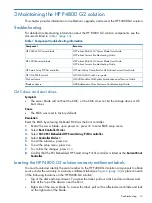
Replacing a server blade
This section describes the implications for the HP P4800 G2 solution software and not the
mechanical aspects of replacing the server blade.
WARNING!
Administrators should verify the firmware version of a replacement server blade
before inserting it in the blade enclosure.
WARNING!
Be sure to only replace a server blade in the bay from which it was removed. Do
not swap or move server blades in a blade enclosure or disk enclosure in HP P4800 G2 solution
systems. If you do, nodes will lose failover ability and you may lose connectivity to the disks and
network.
WARNING!
For cooling practices, do not leave a server bay open for an extended period of
time. When removing an active component, immediately replace it with a blank.
IMPORTANT:
If the boot disk(s) from the blade being replaced are available, placing them in
the new blade allows it to boot to its original configuration. Do
not
reset the network settings if
you are using the original boot disk(s) on the blade being replaced.
IMPORTANT:
If the original boot disk(s) are not available or are damaged, the blade must be
re-imaged using a recovery CD. Doing so requires that the administrator access the console of the
blade through the iLO (or blade KVM dongle) to set the server name and IP address. If you are
not
using the original boot disk(s), be sure to reset the network settings.
IMPORTANT:
The HP P4800 G2 solution should handle a single blade failure for an extended
period of time without loss of data or lost access to the data. The cluster, however, will remain in
a degraded state until the replacement blade is functioning.
To prepare the server blade for replacement:
1.
Confirm the RAID and customer data.
Ensure that RAID is configured on the old blade and that the customer data exists on the disk
enclosures.
2.
Confirm the IP address.
Ensure that the existing server blade is configured with a static or reserved IP address and not
DHCP. If necessary, convert the server blade to a static or reserved IP address. Record this IP
address for verification after the process is complete.
3.
Record the MAC address.
Record the MAC address of the old blade for later use. Also record the server blade hostname
for later verification.
4.
Delete the NIC bond.
Delete any NIC bond previously established on the old blade by using the console or the
CMC. The NIC bond must be deleted because it retains the MAC address of the old blade.
If you are unable to delete the NIC bond at this time, make sure to delete it on the power
cycle following the blade swap.
To replace the server blade or its system board:
1.
Power down the server blade.
To power down the server blade from the CMC, see the “Powering off the storage system”
instructions in the HP P4000 SAN Solution User Guide.
2.
Note the server blade bay number, and then remove the server blade from the blade enclosure.
NOTE:
For instructions on removing and replacing server blade components, see
for the applicable server blade maintenance and service guide.
Replacing the server blade and server blade components
21
Summary of Contents for P4800 G2
Page 4: ...Battery replacement notices 46 Glossary 50 Index 51 4 Contents ...
Page 47: ...French battery notice German battery notice Battery replacement notices 47 ...
Page 48: ...Italian battery notice Japanese battery notice 48 Regulatory compliance notices ...
Page 49: ...Spanish battery notice Battery replacement notices 49 ...






























